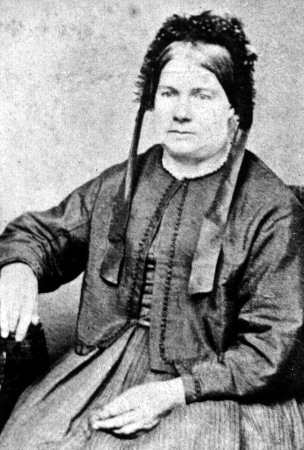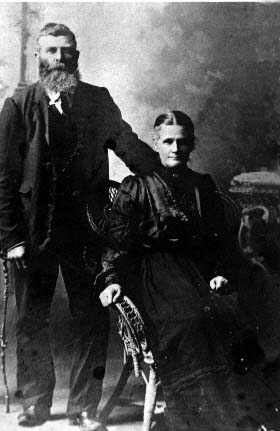
CHAPTER FIVE The Wimmera:- Selection and struggle
Charles Henry Bond apparently came to be widely known and greatly respected in the Wimmera district of western Victoria, at least if one is to judge from the obituary published in the "Horsham Times" on the occasion of his death. 1 He was very active in the Methodist Church, often leading the prayers and singing, and the Bible he used is still in existence although badly dilapidated. 2 It would seem that he was a man who practised what he preached as he is remembered as an extremely kind and generous man, but one who nevertheless insisted on a strict observance of the Lord's Day, with cooking and housework being forbidden. 3
Charles and Betsy had seven children. After the birth of William (April 12th) 1878, came Charles Henry Jr (1881) and Jane (1883) both, like William, born at Kalkee. By the following year it would seem that the family was living at Nurrabiel and it was here that Charles was a prominent member of the local Methodist congregation. 4 During this period the twins Ellen Featherby Bond and Arthur Copeland Bond were born (1886), but Arthur died in infancy and was buried in the Nurrabiel cemetery. 5 By 1888 the family had moved to the Hamilton area with a daughter Frances being born at Warrayure in that year. Finally the family was completed with the birth of Ann at Hamilton in 1890. 6

Elizabeth, wife of James Bond
Not long after this Charles joined with his older brother James to run a small farm with about 600 head of sheep near what was later known as Feery's in Dimboola East. Drought caused the loss of the sheep and the abandonment of the project. The pair then started a butchering business! They operated from a store in Wimmera Street, Dimboola, which later belonged to Fitzgerald's bakery, but apparently this venture too was short lived. 7 Charles then moved to the Colac district where it is probable that his son William first met the young woman who was later to become his wife. Charles returned to the Horsham area, probably around 1904, and took up land at Lower Norton. 8 His brother James remained in Dimboola throughout this time, and afterwards, until his death in 1926.
In the meantime their mother Elizabeth, the wife of James Bond, had died. Her death occurred on Dec 3rd 1887, just one day after her sixty-second birthday. The place of her death is given as Wail, which is close to Pimpinio where she was subsequently buried. The funeral service was conducted by the Rev. Goold of Murtoa, a Primitive Methodist clergyman 9 who later wrote a glowing tribute to her virtues in the Victorian Primitive Methodist magazine. 10 The eulogy portrays Elizabeth as a faithful, self effacing and God-fearing woman who patiently endured a painful cancer disease for the last eight years of her life.
Some five or six years later however James re-married; to a Susan Emmett. The marriage took place in Ballarat in 1892. Although approaching seventy years of age, James fathered two sons Matthew Henry (1893) and Philip James (1894). 11 Perhaps not unexpectedly relations between Susan and James' by now grown-up family were rather cool, and there is some suggestion that some of the sons who had worked to build up a by now prosperous farm were forced to leave the property. The result was that a significant share of the property passed to Susan and then presumably to her two sons, who it seemed experienced some difficulty in being fully accepted by the rest of the family. In fact Matthew enlisted in the army in May 1916 and served in France, England and Belgium as a member of the 22nd Australian Machine Gun Company before being killed in action in Belgium on Jan 12th 1918. He is buried in the Trois Arbres cemetery near Steenwerck in France. 12 Thus after the death of Susan in 1921, any property presumably passed to Philip who continued to live on in James' old home in Pimpinio before moving into an old people's home in Horsham shortly before his death in 1971. 13
James himself, the pioneer of the Bond family in Australia, died of pneumonia on Sept 3rd 1905, and was buried with his first wife Elizabeth and young daughter Jane, at Pimpinio - some 12,000 miles and 80 eventful years from the place and time of his birth. 14 The "Horsham Times" of Sept 5th 1905 referred to James in an obituary as:-"an old and respected resident.. .of a nice genial disposition, and well liked by all who knew him". That he was also hard working and frugal can be inferred from the details contained in his will which I inspected at the Public Records Office in Melbourne. James died a relatively wealthy man with well over 2000 pounds invested in local banks and several pieces of property totalling over 55 acres in area. By contrast and perhaps indicative of a fairly simple lifestyle, his household effects (including an organ) were all together valued at 15 pounds. The other items mentioned in the will were what one might reasonably expect to be in the possession of a retired farmer:- one aged horse, an aged mare, one cow and calf, a small pig, an old three-furrow plough, an old single-furrow plough, an old stripper, an old seed sower, an old buggy with harness (valued at 15 pounds), about ten tons of hay, a trough and a quantity of fowl's feed (but no fowls).
Charles and Betsy Bond
Perhaps the large sum of money which formed part of his estate resulted from a sale of property, as the 55 acres of land owned by James at the time of his death does not seem all that extensive. Under the Selection Act of 1869 which was passed by parliament just before the Wimmera area was opened up for selection, any one person was entitled to take up to 320 acres of land at a cost of one pound per acre. Naturally the value of the land would have increased as it was improved, and the coming of the railway to Horsham in 1879 would have further served to increase land values. In any case, James' achievement to rise from the position of an assisted immigrant to that of a comparatively wealthy and respected farmer, having raised a family of thirteen children in the process, is a tribute to his character and industry, as well as testifying to the wisdom of his decision to migrate taken almost fifty years previously. Sums of money to the value of approximately 200, 150 or 100 pounds were left to each of his surviving children.
It is impossible to say why some children received more than others, maybe James had already loaned money to those who may have been in financial need, or perhaps he left more to those he thought to be in greater need of it. (Charles Henry Bond received a legacy of 98 pounds, 13 shillings and 9 pence). The balance of the estate was left to Susan, which in addition to the property and items already listed meant that she received a sum of over 560 pounds in cash after all expenses, fees and debts had been settled. 15
James' grandson William was married by this time. He married Bridget Theresa Berry at St Georges Church on the corner of Latrobe Terrace and Ryrie St in Geelong in 1899. 16 The steps that bring Bridget and her family into this story will be recounted in the next chapter.
GO TO CHAPTER FIVE FOOTNOTES
GO TO CHAPTER SIX
RETURN TO CONTENTS PAGE